How to Make Meringue (Meringue 101)
Everything you need to know about making a meringue. Plus, 6 tips to achieve the most stable French meringue and visual cues for 3 stages of meringue.
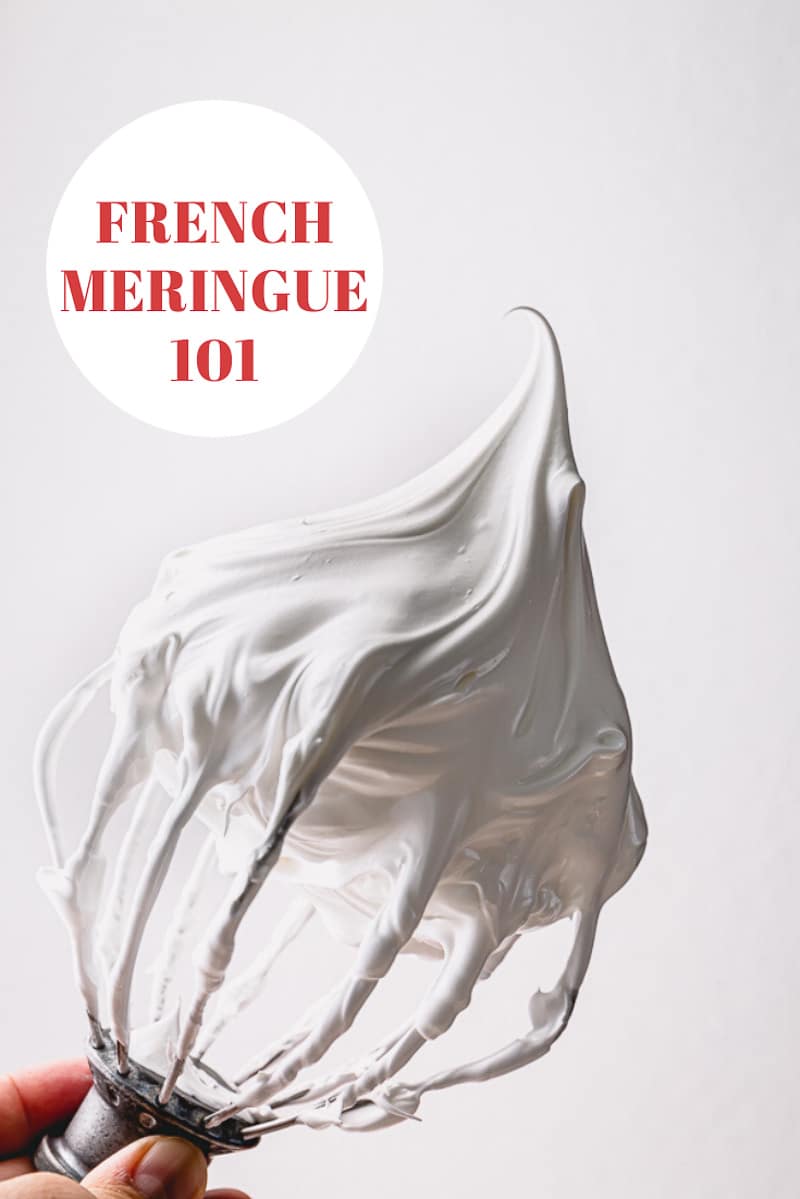
I’m obsessed with meringue based desserts!!!
Pavlova cake, angel food cake, meringue cookies, lemon meringue pie, divinity, and, of course, macarons, just to name a few.
And it’s only appropriate to dedicate an entire post to discuss all the nitty gritty details on making a perfect meringue.
Over the years, I’ve gathered lots of tips and tricks to make the most stable French meringue. And I’m sharing it all with you today.
In this post, we’ll discuss:
- What is meringue? (The science stuff…)
- 3 types of meringue
- 4 stages of meringue
- And the recipe for French meringue
- Plus, 6 tips for making the most stable French meringue
If you prefer, you can watch this video too.

WHAT IS MERINGUE?
Meringue is basically whipped egg whites, often stabilized by sugar and acid.
Let me quickly explain the science behind how meringue is made, which will help you understand the “why”-s behind the strict rules around it.
Egg whites are made up of 90% of water and 10% of protein.
These proteins are made up of long chains of amino acids. Some amino acids are attracted to water – water-loving amino acids, while other amino acids are repelled by water, water-fearing amino acids.
And when we whisk an egg white, we incorporate air bubbles into this water-protein mixture, creating a foam and unraveling those proteins.
When proteins unfold, 2 things happen:
- Water-fearing amino acids are exposed and they move to the air bubbles to stay away from water in the egg white.
- As water-fearing amino acids coat the air bubbles, water-loving amino acids begin to stick together, creating a network that holds the air bubbles in place.
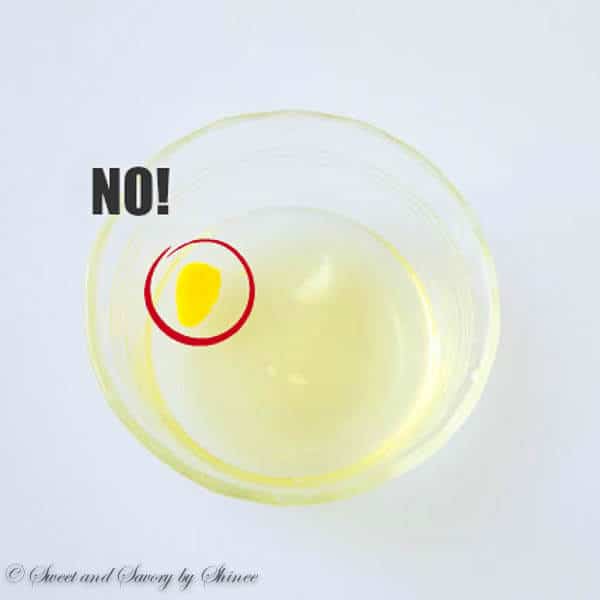
Mục Lục
Why no fat?
Fat interferes with formation of a good foam, because fat is also attracted to air bubbles and they push the proteins away from the bubbles. However, instead of protecting the air bubbles from popping, like protein does, fat molecules actually pop them.
Yolk has fat molecules, and that’s why it’s SO important to be careful not to include any drop of yolk into the egg whites!
RULE #1: Keep the bowls and whisks clean and grease-free. Use stainless steel or glass bowl for whipping meringue, and be careful not to include even smallest drop of egg yolk into the whites.
TIP 1: It’s easier to separate cold eggs straight from the fridge, because yolk is nice and firm.
TIP 2: Room temperature egg whites whip better and get more volume. So separate the egg whites and yolks right out of the fridge, then keep the whites on the counter for about 30 minutes to come to room temperature.
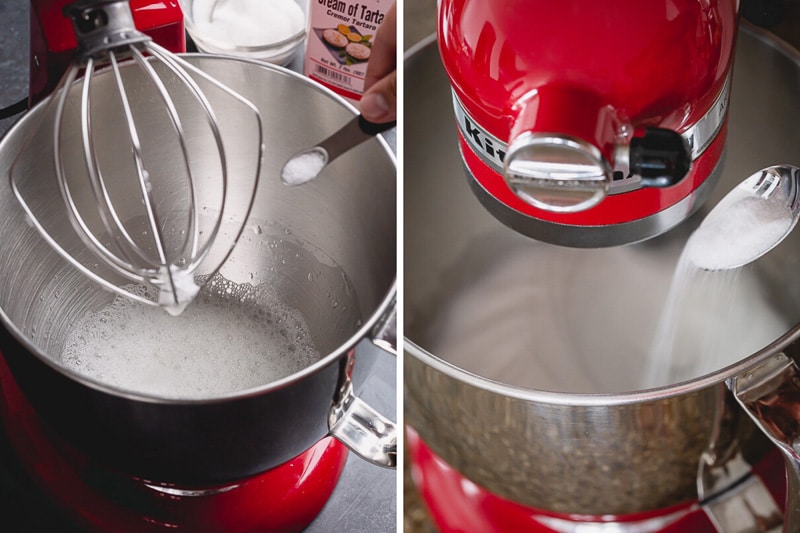
Now, these protein-wrapped bubbles, aka whipped egg whites, are weak and will break down pretty quickly. That’s why it’s important to stabilize it with sugar and acid.
2 stabilizers for meringue:
- Acid in a form of cream of tartar, or lemon juice, or vinegar.
- Sugar.
What role acid plays in meringue?
Adding acid slows down the process of forming a foam, but it prevents too many proteins from linking together, creating stronger and more stable network around the air bubbles.
What role sugar plays in meringue?
Sugar also slows down unfolding the proteins and delaying formation of foam and protecting the egg whites from over-beating.
Also, sugar dissolves, creating thick syrupy coating around the air bubbles, which helps the foam hold stronger.
How much sugar to use for meringue?
The sugar amount depends on the specific recipe and what you’re making with the meringue. Each egg white can hold up to 50gr (¼ cup) of sugar!
TIP: The higher the sugar amount in French meringue, the stronger the meringue will be.
Also, it’s harder to over-beat a meringue if you have higher sugar to egg white ratio.
You need to be careful with meringue where there’s low sugar proportion to egg whites, because you could over-whip the meringue, creating grainy liquid mess.
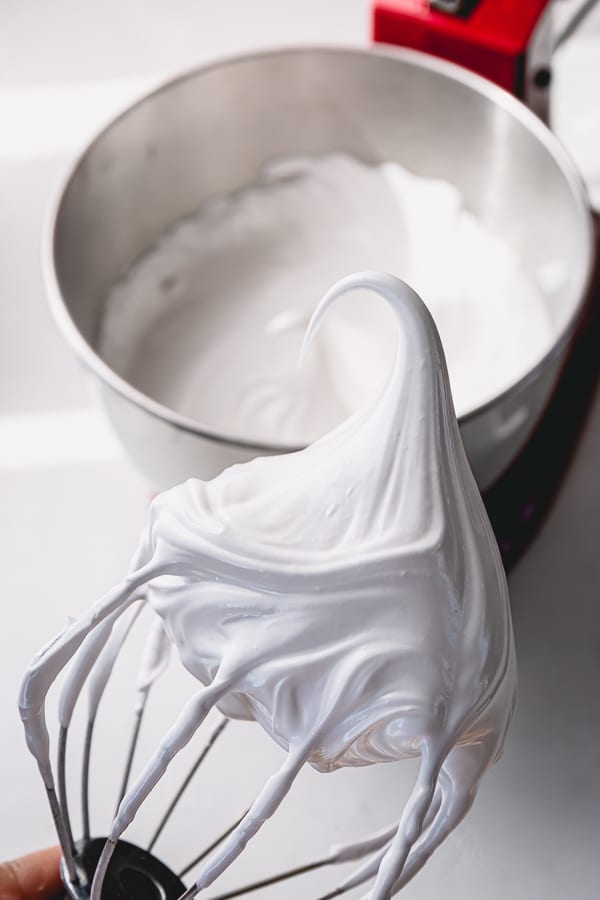
3 TYPES OF MERINGUE:
Now that we understand how it all works, let’s talk about 3 types of meringue.
- Swiss meringue is when you combine egg whites and sugar in a bowl over a double boiler. And then cook it gently until 160°F and then whip it into a meringue. I use this method for mostly Swiss meringue buttercream.
- Italian meringue is when you make a sugar syrup and pour it into whipping egg whites. This is the most stable meringue of all, and it’s ideal for pie topping.
- And finally, French meringue. It’s when you make a meringue by adding sugar into the whipping egg whites.
While French meringue is the least stable of the three methods, it’s my go-to for making macarons.
4 STAGES OF MERINGUE:
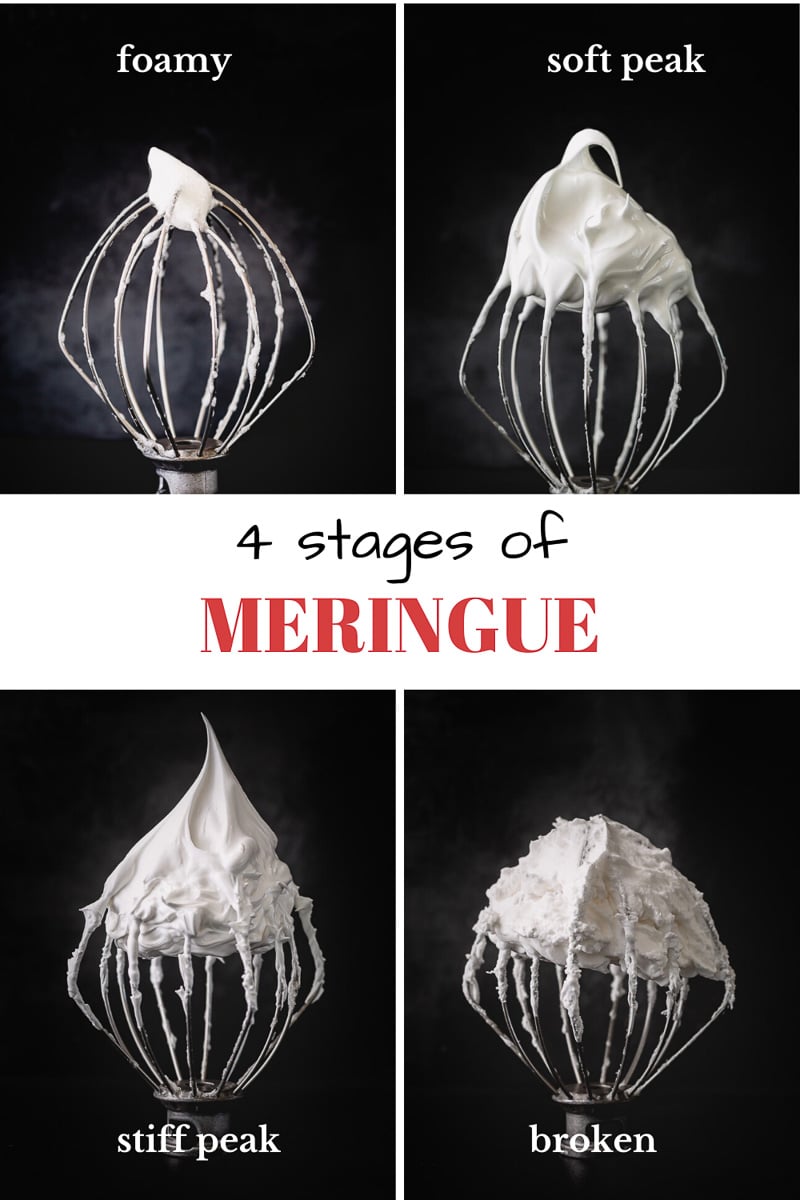
Different recipes call for different meringue consistency, aka meringue stage. There’re 4 stages of meringue, but the 4th one is the failed one and I hope you never get there.
Foamy meringue – This’s the first stage of meringue, when you beat the egg whites for just couple of minutes. It’ll be light and bubbly. Once you get to this stage, you can start adding sugar.
Soft peak meringue – After beating the egg whites with sugar for a little while, meringue turns pure white, shiny and thick. And when you lift the whisk, the meringue doesn’t form a strong pointy peak yet. Instead it kind of curls down. It takes about 5 minutes in my stand mixer on speed 4 to reach soft peaks. Soft peak meringue is often used for sponge cakes, Pavlova, angel food cake, topping meringue pies, etc.
Stiff peak meringue – If you continue to beat the meringue from soft-peak stage, it’ll get even thicker. And as you lift the whisk, the meringue forms a stiff, pointy end. At this stage meringue is super thick, and doesn’t even pour out of the bowl if you turn it upside down. It takes 10-12 minutes to reach stiff peaks in my stand mixer on speed 4. Stiff-peak meringue is used for making meringue cookies, macarons, souffle cheesecake.
Broken meringue – Now, if you whip the egg whites a bit too long, you may get a broken meringue. It looks grainy and separated. There’s a higher chance to get over-whipped broken meringue, if you have lower sugar ratio to egg whites.
How to fix a broken meringue:
If you have a slightly over-beaten meringue, you can salvage it by gently folding in a little bit egg white.
So to sum it all up…
6 TIPS FOR THE MOST STABLE FRENCH MERINGUE:
- Make sure to clean everything that gets in touch with egg whites. Mixing bowl, whisk and everything have to be complete grease-free. And that includes egg yolks. Be very careful not to break the egg yolks. Even the smallest yolk may ruin your meringue! Don’t take the chances here.
- Whip room temperature egg whites for the best volume!
- Beat the meringue on low and steady speed. I usually go for speed 2 or 4 on my KitchenAid mixer. I know it’s tempting to just blast the speed and get the volume up quickly, but the meringue won’t be as stable!
- Make sure to add the sugar slowly, allowing it to dissolve before adding more. If you dump too much sugar in, it’ll deflate all the air bubbles, compromising the structure. Also, if you leave sugar granules undissolved, your meringue will weep later on. To test, rub a little bit of meringue and feel if there is any sugar granules in the meringue. Oh another interesting tip is that you’ll have less chances to over-beat the meringue if you add the sugar slowly!
- Speaking of sugar, get a super fine granulated sugar, aka castor sugar or baker’s sugar, because it dissolves quicker.
- And lastly, make the meringue right before you need it. Meringue will start breaking down if you don’t use it right away.

How to Make French Meringue
Everything you need to know about making a meringue. Plus, 6 tips to achieve the most stable French meringue and visual cues for 3 stages of meringue.
from 1 vote
Prep:
15
minutes
Total :
15
minutes
Ingredients
-
▢
2
egg whites
65-70gr, at room temperature
-
▢
¼
teaspoon
cream of tartar
optional
-
▢
¼
teaspoon
coarse kosher salt
-
▢
75
gr
1/3 cup + 2 tablespoons fine granulated sugar
Note: I test all my recipes with both measurements for the most precise and accurate result!
Instructions
-
In a clean mixing bowl with a whisk attachment, beat the egg whites on medium low speed until foamy. (I set it to speed 2 or 4 on my KitchenAid stand mixer.)
-
When egg whites are foamy, add cream of tartar and salt and continue to whisk.
-
Then slowly add sugar one tablespoon at a time, while mixer is still running. Allow the sugar to dissolve after each addition.
-
Continue beating the egg whites on the same medium low speed until desired stage is reached. About 5 minutes for soft peak stage, and 10-12 minutes for stiff peaks.
Nutrition Facts:
Calories:
323
kcal
(16%)
Carbohydrates:
76
g
(25%)
Protein:
7
g
(14%)
Fat:
1
g
(2%)
Sodium:
682
mg
(30%)
Potassium:
223
mg
(6%)
Sugar:
75
g
(83%)
Calcium:
5
mg
(1%)
Iron:
1
mg
(6%)
* Disclaimer: All nutrition information are estimates only. Read full disclosure here.















![Toni Kroos là ai? [ sự thật về tiểu sử đầy đủ Toni Kroos ]](https://evbn.org/wp-content/uploads/New-Project-6635-1671934592.jpg)


